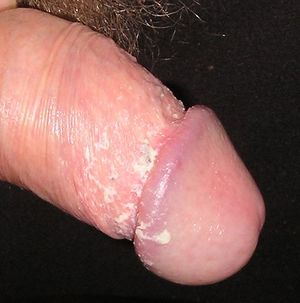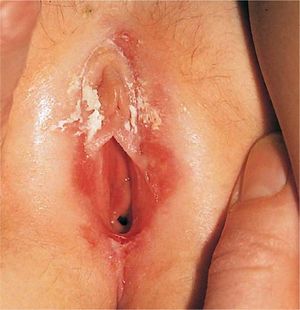Smegma
Smegma is the name given to a flaky material that accumulates underneath the foreskin in males, and underneath the clitoral hood and within the labial folds in females. In males, it is composed of secretions of ectopic sebaceous glands in the foreskin, mixed with secretions of the prostate, seminal vesicles, mucin from the urethral glands, and desquamated epithelial cells.[1] [2] Smegma is not "filth". It is beneficial, benign, and harmless.[3]
Intact adult males who wash their penis and glans daily with clean water usually do not have smegma between the inner foreskin and glans. In infants and boys whose foreskin cannot yet be pulled back (natural phimosis), smegma doesn't matter, while the foreskin protects the glans. The illustration "Smegma on a human penis" is therefore not typical for intact men who wash their genitals regularly.
Excessive washing and the use of soap inside the foreskin should be avoided, because soap removes the skin oil so it can cause non-specific dermatitis that may be mistaken for balanitis.[4]
Contents
Smegma was falsely believed to be carcinogenic
Circumcision advocates of the past who alleged a relationship between "lack of circumcision" and genital cancers formerly implicated smegma or smegma-borne pathogens as the causative agent. Only two histologic studies of human smegma have ever been conducted, both of which found it to be perfectly harmless.
The hypothesis that human male smegma is carcinogenic was first formulated in 1932 by circumcision promoter Abraham L. Wolbarst, M.D.[5] Wolbarst also believed that circumcision prevented epilepsy. (In the early part of the 20th Century, the paroxysm of masturbation in children was often misidentified as an epileptic seizure.) He wrote: "[Circumcision] diminishes the tendency to masturbation, convulsions and other reflex phenomena of local irritation."
No laboratory or clinical research had been done on the subject at the time. Regardless, Wolbarst's hypothesis about smegma and cancer found its way into early medical textbooks. In the 1950s a few experiments were done to test the hypothesis by injecting horse smegma into wounds made in the backs of mice. There were clinical studies that attempted to induce cancer by introducing smegma subcutaneously and intravaginally: No carcinomas could be induced.
The smegma hypothesis was finally disproven by an exhaustive study by Reddy in 1963.[6] His results were: "The conviction that human smegma is a carcinogen could not be substantiated."
Van Howe & Hodges (2006) concluded: "The purpose of the scientific method is to distinguish between wishful thinking, strongly held opinion, and provable fact. The smegma theory of disease, which began as wishful thinking on the part of circumcision zealots such as Abraham Wolbarst and Abraham Ravich, has evolved into irrefutable dogma, but as modern physicians, we need to recognize that, until proved otherwise, smegma is harmless."[3]
Beneficial aspects of smegma
Smegma contains natural skin oils that are beneficial to the health of the mucosa that covers the glans penis. The oil also has lubricating advantages.[7]
See also
External links

Smegma 101
. Retrieved 20 June 2020.
 Hill, George (9 November 2008).
Hill, George (9 November 2008). The “foreskin causes cancer” myth
, Wordpress, genitalwholeness. Retrieved 6 December 2020.
Quote:Circumcision alters human behavior. Many males who originate in circumcising cultures, and who are likely to be circumcised, have special emotional issues. Circumcised doctors, therefore, tend to behave differently from normal doctors. Those who become doctors may use junk science to promote male circumcision. The myth of cancer protection by circumcision continues to be a favourite claim of such doctors.
References
- ↑
 Parkash S, et al. Sub-Preputial Wetness - Its Nature. Ann Nat Med Sci (India). 1982; 18(3): 109-112. Retrieved 16 October 2019.
Parkash S, et al. Sub-Preputial Wetness - Its Nature. Ann Nat Med Sci (India). 1982; 18(3): 109-112. Retrieved 16 October 2019.
- ↑
 Hyman AB, Brownstein MH. Tyson's
Hyman AB, Brownstein MH. Tyson's Glands
. Archives of Dermatology. January 1969; 99(1): 31-37. Retrieved 16 October 2019. - ↑ a b
 Van Howe RS, Hodges FM. The carcinogenicity of smegma: debunking a myth. J Eur Acad Dermatol Venereol. 2006; 20(9): 1046. DOI. Retrieved 16 October 2019.
Van Howe RS, Hodges FM. The carcinogenicity of smegma: debunking a myth. J Eur Acad Dermatol Venereol. 2006; 20(9): 1046. DOI. Retrieved 16 October 2019.
- ↑
 Birley HDL, Walker MM, Luzzi GA, Bell R, et al. Clinical Features and management of recurrent
balanitis; association with atopy and genital
washing]. Genitourin Med. October 1993; 69(5): 400-3. PMID. PMC. DOI. Retrieved 28 February 2020.
Birley HDL, Walker MM, Luzzi GA, Bell R, et al. Clinical Features and management of recurrent
balanitis; association with atopy and genital
washing]. Genitourin Med. October 1993; 69(5): 400-3. PMID. PMC. DOI. Retrieved 28 February 2020.
- ↑
 Wolbarst AL. Circumcision and Penile Cancer. The Lancet. 16 January 1932; 1(5655): 150-153. DOI. Retrieved 16 October 2019.
Wolbarst AL. Circumcision and Penile Cancer. The Lancet. 16 January 1932; 1(5655): 150-153. DOI. Retrieved 16 October 2019.
- ↑
 Reddy DG, Baruah IK. Carcinogenic action of human smegma. Archives of Pathology. April 1963; 75(4): 414-420. Retrieved 16 October 2019.
Reddy DG, Baruah IK. Carcinogenic action of human smegma. Archives of Pathology. April 1963; 75(4): 414-420. Retrieved 16 October 2019.
- ↑
 Wright J. How smegma serves the penis. Sexology. September 1970; 37(2): 50-3. Retrieved 21 June 2020.
Wright J. How smegma serves the penis. Sexology. September 1970; 37(2): 50-3. Retrieved 21 June 2020.


